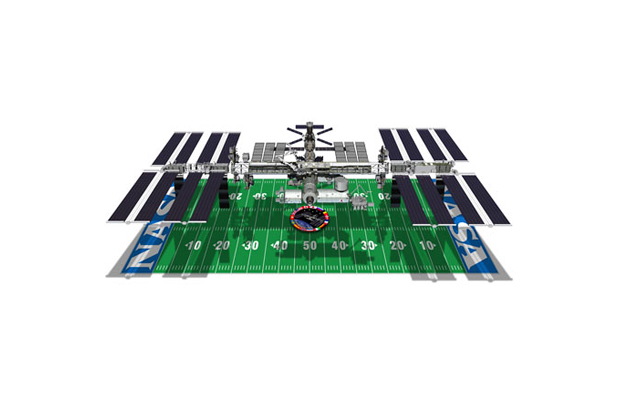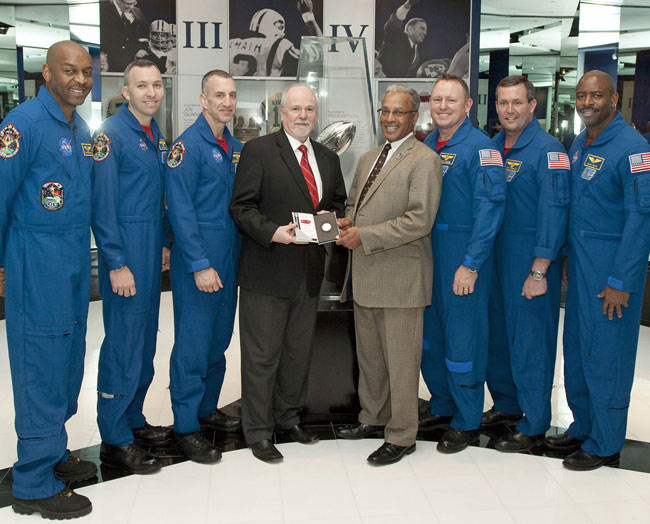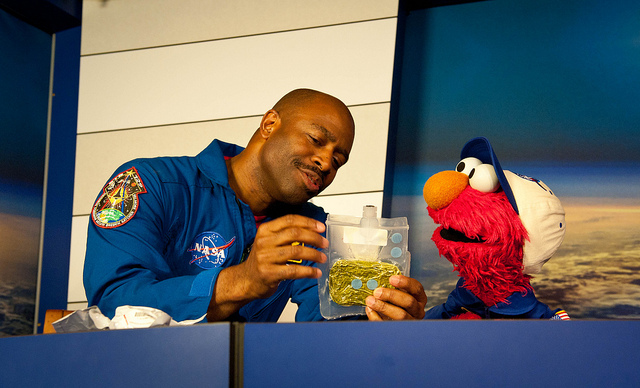Super Bowl Space Tech: NASA Makes the Big Game Possible

NASA and the Super Bowl may not be two things you'd normally put in the same sentence together, but Sunday's big game wouldn't be the same without innovative spinoff technologies from space exploration.
From helmets to headsets to the communications satellites that allows fans to watch around the world, NASA's legacy can be found throughout the Super Bowl Sunday experience. So when the Seattle Seahawks face off against Denver's Broncos, the teams will have NASA to thank for some of their basic tech needs.
Here's a look at some of the NASA's space technology spinoffs (and some pop culture, too) that have found their way into Super Bowl:
Helmet foam
Consider the football helmet. On Sunday, players for the Seahawks and Broncos won't venture onto the MetLife Stadium field in East Rutherford, N.J., without one and they're filled with tech inspired by NASA. [In Photos: NFL Stadiums That Have Hosted the Super Bowl]
In the 1960s, engineers at NASA's Ames Research Center in California studied a shock-absorbing foam with the intent of minimizing the stresses suffered by pilots subjected to high g-forces. Known as Temper Foam, or memory foam, the polyurethane material shapes itself around objects after compression and returns to its original form. Today, the material has a wide variety of everyday uses, including serving as the padding inside of football helmets, NASA officials explained in a statement.
Those shiny helmets
Breaking space news, the latest updates on rocket launches, skywatching events and more!
Cushion isn't the only part of the helmet NASA had a hand in. The outside shell of the familiar headgear is made of Lexan. Originally developed by a German scientist in the early 1950s, the material caught the eye of NASA engineers, who tested it and realized that it could stop a bullet, a micrometeroid, or the sacking of your favorite quarterback.
Wireless QB radio headsets
Football players aren't the only ones donning space-inspired headgear. After astronaut Gus Grissom nearly drowned when the Liberty Bell 7 capsule completed America's second manned mission, engineers at NASA sought for a way to avoid losing contact with their astronauts. NASA and Pacific Planotronics (now Planotronics, Inc.) jointly developed a way to implant the headsets, which included a noise-canceling feature, inside of an astronaut's helmet. Today, coaches utilize the wireless headsets to communicate with one another along the sidelines. [NASA's New Z-1 Spacesuit Design in Photos]
Satellite communications for TV broadcasts
NASA has helped to improve communication not only between coaches but around the world. With the launch of the NASA-developed Telstar 1 satellite in 1962, the world realized a new era of television broadcasting. Part of a multi-national agreement, the original satellite sought to extend communications across the vast Atlantic Ocean. Today, its descendents allow fans to watch the Super Bowl from 185 countries.
NASA's NFL astronaut
Not all of NASA's football links are quite so direct.
Astronaut Leland Melvin served on two space shuttle missions after he began training as an astronaut in 1998. But he had already gotten up close and personal with NASA's helmet technologies, having been drafted as a wide receiver by the Detroit Lions in 1986. He reported to the Dallas Cowboys the following year, before a pulled hamstring spelled the end of his football career.
Super Bowl coin flips
In 2010, officials made the opening toss of Super Bowl XLIV with a space-flown coin that had traveled to heights only dreamed of by most NFL fans. The silver medallion logged a total of 4 million miles over the course of 171 orbits around the Earth aboard the space shuttle Atlantis, flying with football player-turned-astronaut Melvin. On Jan. 27 of that year, the coin was presented to the Pro Football Hall of Fame before heading to Florida to open the Big Game.
In 1992, television station CBS asked NASA if it would be willing to provide the pre-game coin toss on board the Discovery Space Shuttle. Knowing that a coin flipped in space would never actually land, Canadian astronaut Roberta Bondar held the coin in her right hand and flipped twice in space before releasing it to drift. According to the crew, the coin came up heads, the same as the actual pre-game coin toss came up.
NASA and Super Bowl commercials
The Super Bowl wouldn’t be complete without its long-heralded commercials, and NASA has played a role there too, agency officials said.
During the 2011 Super Bowl, NASA'snext-generation humanoid robot Robonaut 2 debuted during a General Motors advertisement that showcased the robot's ability to work alongside humans. The two companies are working to develop climbing legs for the robot to allow it to move outside the football-field sized International Space Station, with the hopes that it can one day take over tasks deemed too dangerous for astronauts.
Though few link football and NASA together, the two share quite a bit of common ground. Athletes may not be kicking field goals on the moon in the near future, but they certainly have quite a few reasons to thank NASA.
To learn more about NASA's spinoff technologies, visit: http://spinoff.nasa.gov/
Follow us @Spacedotcom, Facebook and Google+. Original article on Space.com.

Nola Taylor Tillman is a contributing writer for Space.com. She loves all things space and astronomy-related, and always wants to learn more. She has a Bachelor's degree in English and Astrophysics from Agnes Scott College and served as an intern at Sky & Telescope magazine. She loves to speak to groups on astronomy-related subjects. She lives with her husband in Atlanta, Georgia. Follow her on Bluesky at @astrowriter.social.bluesky


